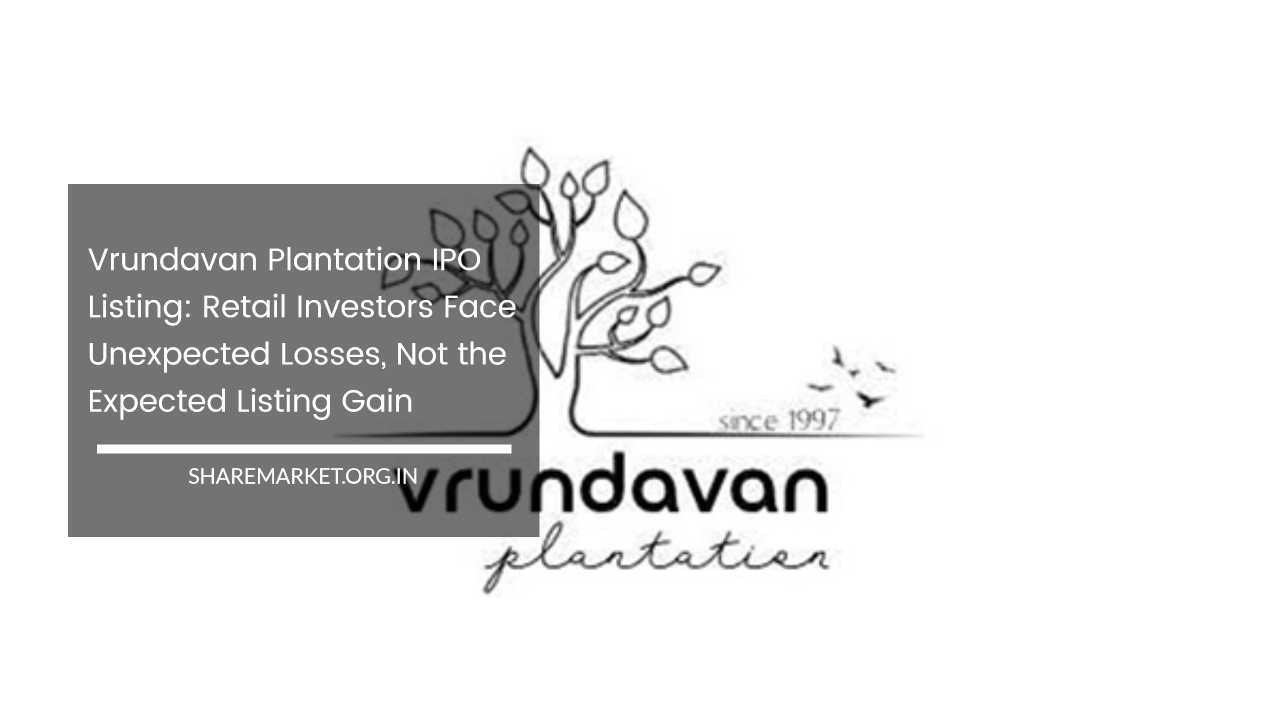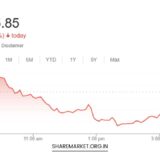Vrundavan Plantation IPO Listing: Retail Investors Face Unexpected Losses, Not the Expected Listing Gain

Vrundavan Plantation IPO Listing
Vrundavan Plantation IPO Listing: A Pioneer Since 1997
Vrundavan Nursery, a trusted name in the nursery business, has been catering to the needs of plant enthusiasts since its establishment in 1997. Their extensive experience and commitment to green initiatives have made them a notable player in the industry.
However, despite this strong reputation, the company’s recent foray into the stock market saw a lukewarm reception on the SME platform of the Bombay Stock Exchange (BSE). The Vrundavan Plantation IPO garnered significant attention from retail investors, with an overall subscription rate exceeding 18 times.
During the IPO, shares were initially issued at a price of Rs 108 per share. Unfortunately, the stock entered the BSE SME at a price of Rs 107 per share, leading to an unexpected loss of about 1 percent for IPO investors. Matters worsened after listing, as the shares dipped further, hitting Rs 101.65 (Vrundavan Plantation Share Price) and closing at the same level, translating to an approximate 6 percent loss on the very first day.
This development was a disappointment to retail investors who had placed substantial investments in Vrundavan Plantation IPO. The IPO, which raised Rs 15.29 crore, was open for subscription from October 30 to November 1.
Remarkably, it received an overwhelming response, with a subscription rate of 18.57 times, primarily driven by enthusiastic retail investors, who subscribed 25.51 times the portion reserved for them. Under this IPO, 14.16 lakh new shares with a face value of Rs 10 were issued.
The funds generated through the issuance of these new shares were earmarked for various purposes, including addressing working capital requirements, debt repayment, general corporate expenses, and related costs.
Vrundavan Nursery’s mission revolves around tending to 10 million hectares of forest and non-forest land with the aim of increasing forest cover and enhancing the quality of existing forests, not only in India but worldwide.
When assessing the financial performance of the company, it reported a net profit of Rs 17.33 lakh and a revenue of Rs 1.81 crore in the last fiscal year of 2023. However, it’s worth noting that the company also carried a loan of Rs 17.47 lakh during this period.
In summary, the Vrundavan Plantation IPO listing had generated significant anticipation among retail investors, but its underwhelming performance on the stock market was unexpected, resulting in initial losses for IPO investors.
Despite this setback, Vrundavan Nursery continues its mission of promoting green initiatives and enhancing the world’s forested areas.
Understanding the Vrundavan Plantation IPO Listing
The Vrundavan Plantation IPO listing has garnered significant attention due to the unexpected losses incurred by retail investors during its initial days on the stock market.
To comprehend this development fully, it’s essential to delve deeper into the details of Vrundavan Nursery’s background, the IPO subscription process, and the factors contributing to the stock’s lackluster performance.
Vrundavan Nursery: A Legacy of Green Initiatives
Vrundavan Nursery has been a prominent player in the nursery business since its inception in 1997. With over two decades of experience, the company has built a strong reputation for its commitment to green initiatives and environmental sustainability.
Its core activities encompass various aspects of land preparation, maintenance, gardening, tree planting, and irrigation.
One of the most remarkable aspects of Vrundavan Nursery’s mission is its ambitious goal to oversee and enhance 10 million hectares of forest and non-forest land.
The company is dedicated to increasing forest cover and improving the quality of existing forests, not only in India but also around the world. This noble vision aligns with global efforts to combat deforestation, mitigate climate change, and preserve biodiversity.
Financial Snapshot of Vrundavan Nursery
To better understand the Vrundavan Plantation IPO and its implications, it’s essential to review the financial performance of Vrundavan Nursery in the last fiscal year, which ended in 2023.
During this period, the company reported a net profit of Rs 17.33 lakh, indicating a relatively modest but positive financial outcome.
In addition, Vrundavan Nursery generated a revenue of Rs 1.81 crore, demonstrating a substantial inflow of funds through its business activities.
However, it’s worth noting that the company also had a loan of Rs 17.47 lakh during this period. While the loan amount is relatively small compared to its revenue and profit figures, it’s a financial aspect that potential investors may consider when evaluating the company’s financial health and stability.
The Vrundavan Plantation IPO Journey
The Vrundavan Plantation IPO presented an opportunity for retail investors and the broader market to participate in the growth and development of Vrundavan Nursery. The IPO opened for subscription between October 30 and November 1, 2023, with high expectations among investors.
The IPO subscription process witnessed an enthusiastic response, with an overall subscription rate exceeding 18 times.
Retail investors, in particular, showed strong interest, subscribing at a rate of 25.51 times the portion reserved for them. This overwhelming demand suggested a significant appetite for Vrundavan Nursery’s shares in the market.
Under the IPO, a total of 14.16 lakh new shares with a face value of Rs 10 were issued to raise funds. The utilization of these funds was planned for various purposes, including:
- Addressing Working Capital Requirements: Working capital is essential for a company’s day-to-day operations, covering expenses such as salaries, raw materials, and utility bills. By allocating funds to working capital, Vrundavan Nursery aimed to ensure the smooth functioning of its business activities.
- Debt Repayment: Debt reduction is a prudent financial strategy, as it reduces the company’s financial liabilities and interest costs. The IPO funds were intended to be used for repaying existing debts, potentially improving the company’s financial position.
- General Corporate Expenses: Companies incur various general corporate expenses, including administrative costs, marketing expenses, and regulatory compliance costs. These funds were allocated to meet these requirements.
- Issue-Related Expenses: The process of conducting an IPO involves significant expenses, such as underwriting fees, legal costs, and regulatory compliance costs. A portion of the funds raised was set aside to cover these expenses.
The Vrundavan Plantation IPO Listing: Unexpected Losses
Despite the high subscription rates and the anticipation surrounding the Vrundavan Plantation IPO, the stock’s performance on the SME platform of BSE was far from impressive.
The shares, which were initially issued at a price of Rs 108, entered the stock market at a price of Rs 107. This minor deviation from the issue price resulted in an unexpected loss of about 1 percent for IPO investors on the first day.
The disappointment continued as the shares experienced a further decline, closing at Rs 101.65 on the same day, translating to an approximate 6 percent loss for IPO investors.
This was a surprising turn of events, especially considering the strong response the IPO received from retail investors and the overall subscription rate of over 18 times.
This turn of events raised questions among market participants and investors who had eagerly anticipated the IPO’s listing.
Retail investors, in particular, who had invested significant amounts in the IPO, were left wondering why the stock didn’t perform as expected.
Factors Contributing to the Lackluster Performance
The lackluster performance of Vrundavan Plantation IPO shares can be attributed to several factors:
- Market Sentiment: Market sentiment plays a significant role in the performance of newly listed stocks. Despite the strong subscription rates, broader market conditions, economic uncertainties, and global factors can impact investor sentiment. In this case, market sentiment might have shifted on the listing day, leading to the stock’s decline.
- Pricing Discrepancy: The slight deviation between the issue price of Rs 108 and the listing price of Rs 107 may have contributed to the initial loss for IPO investors. Investors often expect a listing gain, and any difference between the issue price and listing price can influence their perception of the stock.
- Immediate Selling Pressure: Some investors who subscribed to the IPO may have decided to sell their shares immediately upon listing in an attempt to secure a quick profit. This selling pressure can drive down the stock price, especially if there are more sellers than buyers in the market.
- Liquidity Concerns: SME platforms, like the one on which Vrundavan Plantation shares were listed, may have lower liquidity compared to larger exchanges. Limited liquidity can result in price volatility and a higher likelihood of substantial price swings, as seen in this case.
- Market Dynamics: The stock market is influenced by a complex interplay of supply and demand, investor sentiment, economic conditions, and company-specific factors. In the case of Vrundavan Plantation, a combination of these dynamics might have contributed to the stock’s underwhelming performance.
Conclusion: Evaluating the Vrundavan Plantation IPO
The Vrundavan Plantation IPO listing is a testament to the unpredictability of the stock market. Despite the strong response from retail investors and the impressive subscription rates, the stock entered the market with unexpected losses for IPO investors.
While this outcome may be disappointing for those who invested in the IPO, it underscores the importance of conducting thorough research and due diligence before participating in such offerings.
Investors should consider a range of factors when evaluating an IPO, including market conditions, pricing, the company’s financial health, and the broader economic environment. It’s also essential to have a clear understanding of the company’s business model, objectives, and plans for utilizing the IPO funds.
The Vrundavan Plantation IPO listing serves as a reminder that stock market investments carry inherent risks, and careful consideration is vital for making informed investment decisions.
Despite the initial setbacks, Vrundavan Nursery continues its mission of contributing to global environmental sustainability by tending to and expanding forested areas. While the stock market’s response was not as expected, the company’s commitment to green initiatives and enhancing the world’s forest cover remains unwavering.
Investors and market observers will continue to monitor the performance of Vrundavan Plantation shares as the company navigates the complexities of the stock market.
The ultimate success of the IPO may depend on various factors, including market sentiment, the company’s ability to achieve its objectives, and broader economic conditions.
As with any investment, staying informed and adapting to changing circumstances is essential for long-term success in the stock market.

















